Physical Address
304 North Cardinal St.
Dorchester Center, MA 02124
Physical Address
304 North Cardinal St.
Dorchester Center, MA 02124
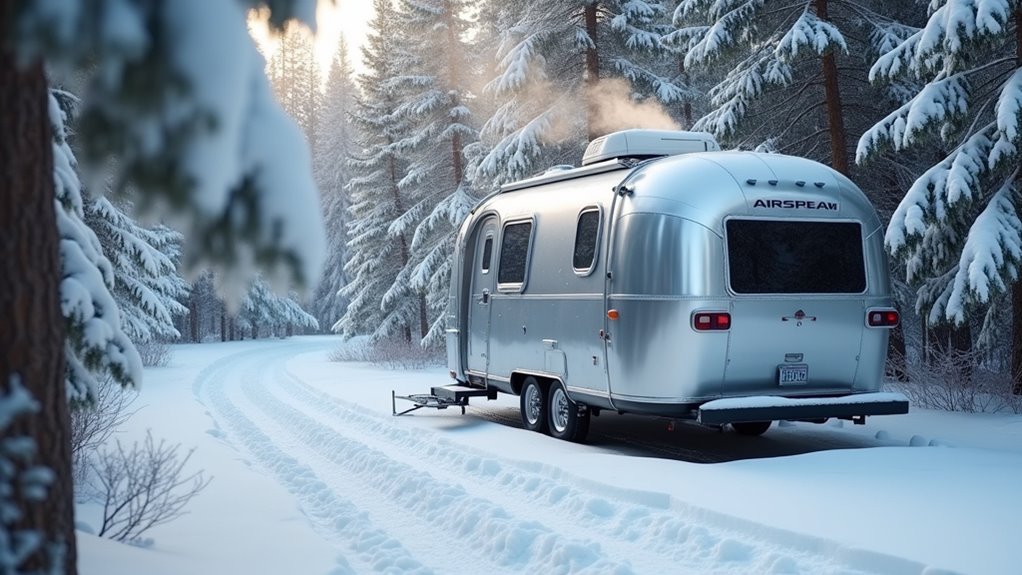
Winter RV camping doesn't require expensive upgrades – discover which preparations actually matter and which costly "essentials" you can completely skip.
You’ve probably heard the warnings about winter RV camping – frozen pipes, dead batteries, and sky-high propane bills. But here’s the truth: thousands of RVers successfully chase snowbird seasons and winter adventures without breaking the bank or their rigs. The key isn’t avoiding cold weather camping altogether; it’s understanding which preparations actually matter and which expensive “upgrades” you can skip. Let’s separate the marketing hype from real-world necessities.
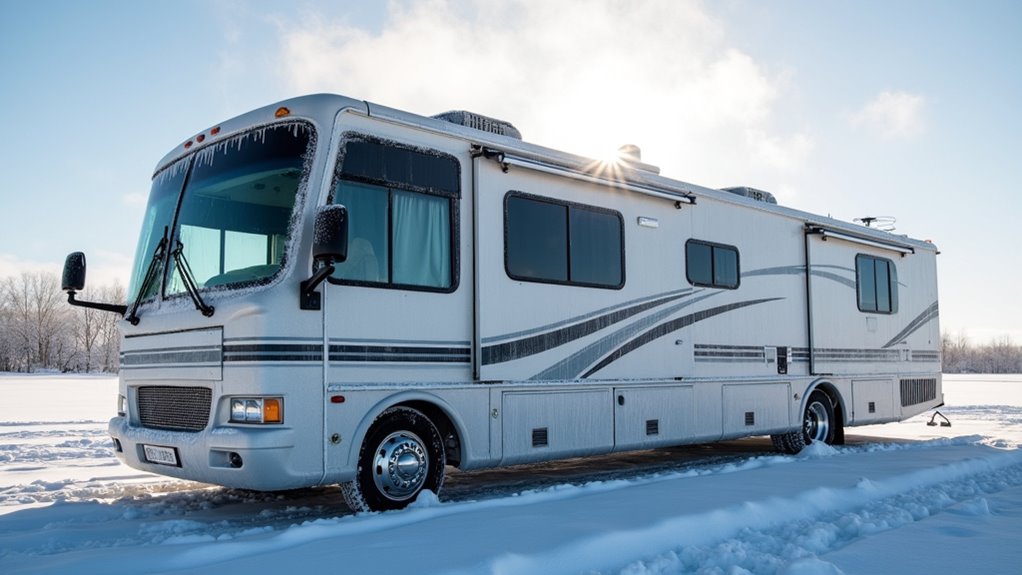
Before you venture into winter’s harsh embrace, your RV needs a thorough inspection and preparation routine that’ll save you from costly breakdowns and uncomfortable nights.
Start with your heating system – clean filters, test propane connections, and stock extra tanks. You’ll burn through fuel faster than expected.
Check your water system next. Drain tanks completely or add RV antifreeze to prevent frozen pipes that’ll cost hundreds to repair.
Inspect your battery bank and charging system. Cold weather kills battery capacity, so consider upgrading or adding a second battery.
Don’t forget tire condition – winter roads demand good tread and proper pressure.
Finally, pack emergency supplies: extra blankets, flashlights, non-perishable food, and basic tools. These preparations aren’t glamorous, but they’re essential for safe, comfortable winter adventures.
If you’re considering different recreational options for your winter adventures, weigh the costs and benefits of renting versus buying equipment to maximize your outdoor experience budget.
When temperatures plummet below freezing, your RV’s plumbing becomes vulnerable to expensive damage that can sideline your trip and drain your wallet. You’ll need to take proactive steps to prevent costly freeze-ups.
Start by insulating exposed pipes with foam sleeves or heat tape. Focus on areas under your RV where pipes run through unheated compartments. Keep cabinet doors open near plumbing to allow warm air circulation.
Insulate exposed pipes with foam sleeves or heat tape, especially in unheated compartments beneath your RV.
Let faucets drip slightly during extremely cold nights – moving water freezes slower than stagnant water. You can also leave your water pump running intermittently to maintain circulation.
Consider investing in tank heaters for your fresh, gray, and black water tanks. These affordable additions prevent freezing and keep your systems operational throughout winter camping adventures.
While winter RV camping presents unique challenges, applying hot-weather camping preparation principles like thorough system checks and proactive maintenance will help ensure your cold-weather adventures remain comfortable and trouble-free.
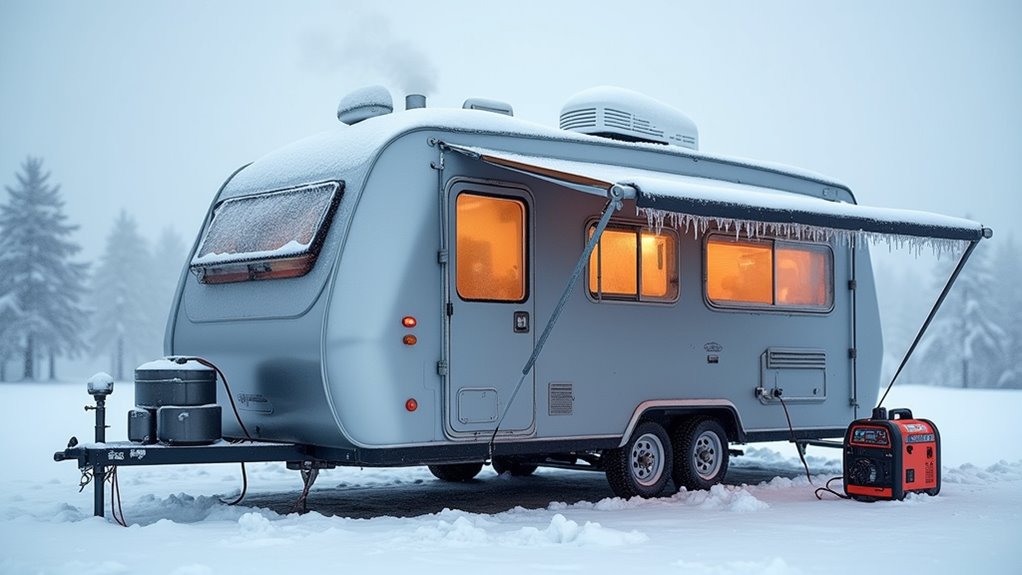
While your RV’s plumbing stays protected from freezing, you’ll need efficient heating that won’t break the bank or drain your power reserves. Your propane furnace works great but burns through fuel fast. Consider supplementing with a ceramic space heater when you’re plugged into shore power – they’re cheaper to run and heat specific areas effectively.
Layer your heating approach: use electric blankets at night, close off unused sections with curtains, and add insulation around windows.
A small catalytic heater provides backup warmth without electricity, though proper ventilation‘s essential.
Monitor your power consumption with a meter to avoid costly surprises. Run high-draw appliances one at a time, and invest in LED bulbs to reduce electrical load.
Smart energy management keeps you warm without emptying your wallet. Avoid common RV mistakes by researching heating systems thoroughly before making any major purchases for your winter camping setup.
Although most RVers focus on interior preparations, your rig’s exterior needs just as much attention to survive harsh winter conditions. Start by inspecting and sealing all exterior seams with affordable RV sealant—preventing water infiltration that’ll freeze and cause expensive damage.
Don’t forget your undercarriage. Insulate exposed pipes with foam sleeves or heat tape, but avoid cheap options that fail when temperatures drop. Disconnect and drain your water hose, then store it inside to prevent cracking.
Check your roof vents and close them tightly, except for necessary ventilation.
Apply tire covers to protect against UV damage and temperature fluctuations. Finally, keep your propane tanks full—they perform better in cold weather when topped off, and you’ll avoid midnight runs for refills.
For those seeking year-round adventure, consider how these winterization techniques could prepare your RV for exploring challenging terrains like the Andes mountains, where temperature extremes demand properly protected equipment.
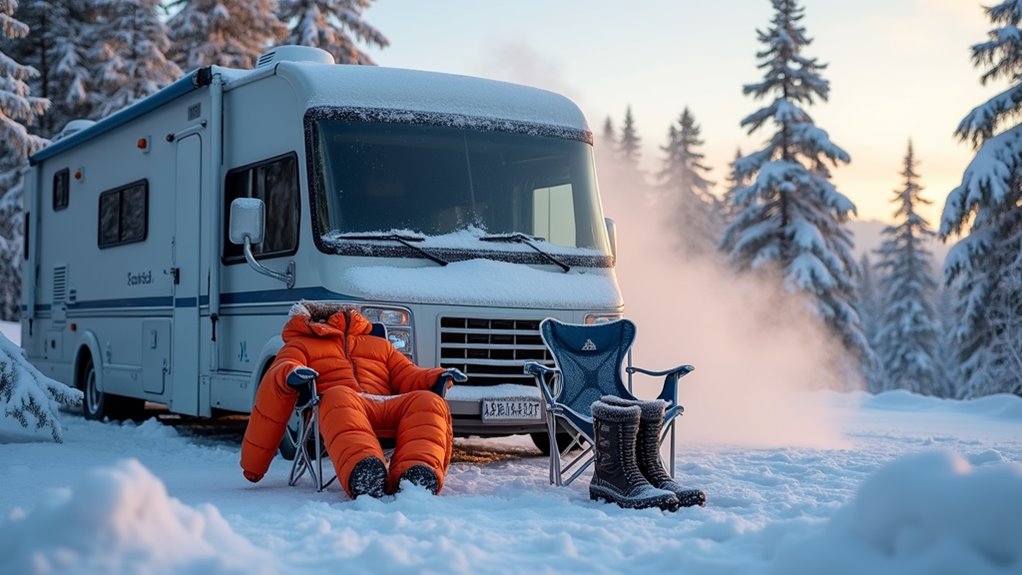
Your RV might be winter-ready, but you won’t last long in freezing temperatures without proper clothing and gear. Layer smart with moisture-wicking base layers, insulating mid-layers, and waterproof outer shells. Don’t skimp on quality boots – frostbitten toes aren’t worth saving twenty bucks.
Pack extra socks, gloves, and hats since wet gear becomes useless fast. A good headlamp beats fumbling with flashlights in bulky gloves. Keep hand warmers stocked for emergencies and outdoor activities.
Budget-friendly finds include thrift store wool sweaters and military surplus gear. Check clearance sales at outdoor retailers during off-season. Your smartphone battery drains faster in cold, so carry a portable charger.
Finally, pack a basic first-aid kit with supplies for treating minor cold-related injuries. Don’t forget a reliable camping water filter since access to clean drinking water remains crucial even in winter conditions.
When winter weather hits the road, driving your RV becomes a completely different beast than cruising through summer sunshine. You’ll need to slow down considerably – reduce your speed by at least 25% on snowy roads.
Leave triple the normal following distance between you and other vehicles since RVs take longer to stop on slippery surfaces.
Check your tire chains before leaving home and practice installing them in your driveway. It’s cheaper than roadside assistance and you’ll avoid fumbling in freezing conditions.
Keep momentum steady when climbing hills, but don’t gun it if you start sliding.
Pull over and wait out severe storms rather than risking an accident. Your safety’s worth more than any schedule.
Before hitting winter roads, review comprehensive safety tips to ensure you’re prepared for all potential hazards that come with motorhome travel in challenging conditions.
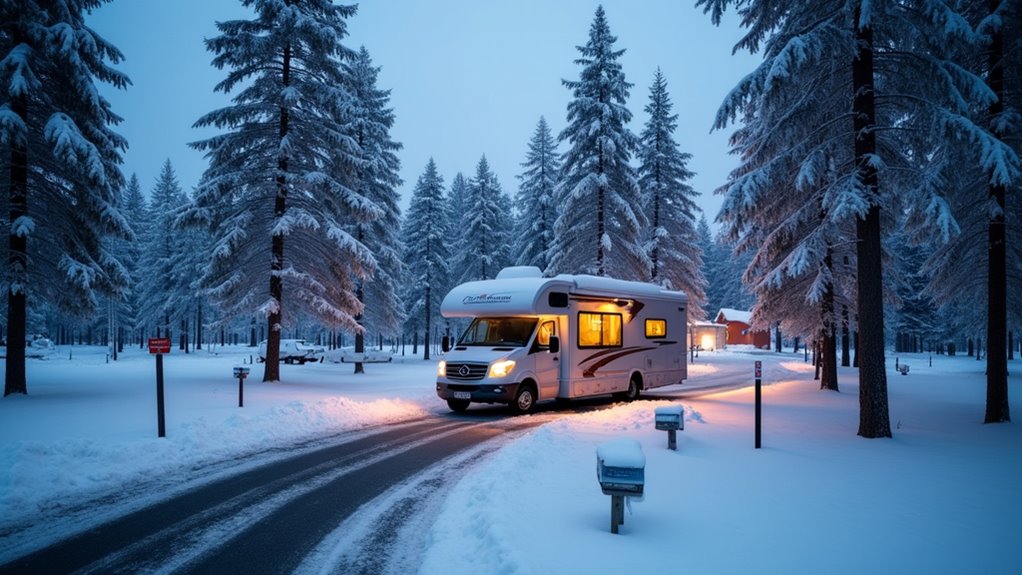
Getting to your destination safely means nothing if you don’t have a warm place to park for the night. Finding winter-friendly campgrounds requires research and planning, but it’s worth the effort to avoid freezing temperatures and unexpected closures.
Winter RV camping success depends on thorough research and advance planning to secure warm, accessible campgrounds before hitting the road.
Start by calling campgrounds directly – websites aren’t always updated with winter availability. Ask specific questions about their winter operations and amenities.
Budget-conscious RVers should book early for winter discounts and consider extended-stay rates at parks offering monthly deals. Don’t forget to research what camping shower options are available at winter campgrounds, as some facilities may have limited hot water or seasonal closures that could impact your hygiene routine.
Even with the most careful planning, severe weather can strike without warning and turn your winter RV adventure into a dangerous situation. You’ll need an extensive emergency kit that won’t break the bank. Stock up on extra propane tanks, battery-powered radio, flashlights, and backup batteries.
Keep at least three days’ worth of non-perishable food and water per person. A portable generator can be a lifesaver, but cheaper alternatives include power banks and solar chargers.
Download weather apps and monitor forecasts religiously. Know your evacuation routes and have backup plans. Keep emergency contact numbers handy and inform someone of your travel plans.
Pack extra blankets, warm clothing, and first-aid supplies. Most importantly, don’t hesitate to cut your trip short if conditions deteriorate rapidly.
While most winter RV camping involves standard trails, some adventurous campers may find themselves near mountainous terrain where glacier climbing activities require similar emergency preparedness protocols.
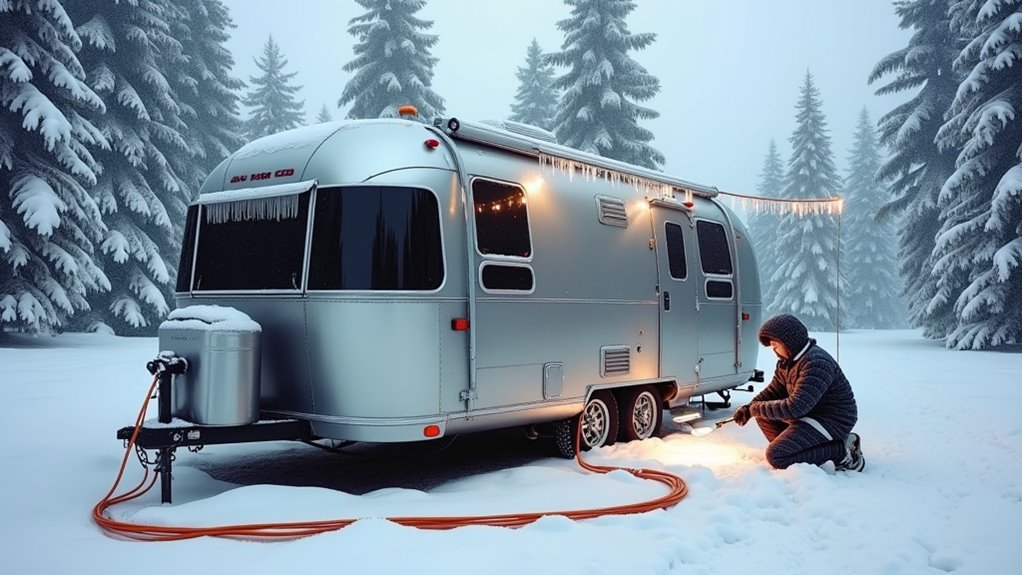
While you’re settled in for an extended winter stay, regular maintenance becomes essential to prevent costly repairs and keep your RV running smoothly in harsh conditions.
Don’t let winter’s demands catch you off guard. These routine tasks will save you money and headaches:
Winter waits for no one – stay ahead of costly RV repairs with these simple preventive maintenance tasks.
You’ll catch small problems before they become expensive disasters.
Set reminders on your phone for these tasks – consistency beats perfection when you’re living on a budget.
Keep your maintenance tools and emergency supplies organized with a Response Pak so everything stays accessible during harsh weather conditions.
Remember, you don’t have to break the bank to winter RV successfully. You’ve got the knowledge now – proper insulation, frozen pipe prevention, smart heating choices, and emergency prep. As they say, “an ounce of prevention is worth a pound of cure,” and that’s especially true when you’re dealing with freezing temperatures. Stick to your maintenance routine, drive cautiously, and choose campgrounds wisely. You’ll conquer winter camping while keeping costs reasonable.